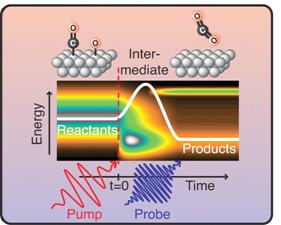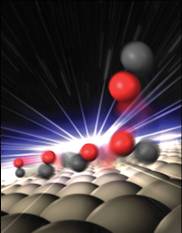2.3. Basic energy science
2.3.3. Catalysis
One of the main promising routes to solve the energy problem in a sustainable way is to convert sunlight into fuels that have a high energy density and are easy to store and transport. Here, hydrocarbons have proven to be superior and despite decades of efforts to substitute the oil economy, no other approach prevailed. Thus, the question remains how to convert sunlight into energy containing hydrocarbons.
The fundamental idea is to mimic a photosynthetic process, where sunlight is absorbed in a material (solid) and the energy is used to form and break specific bonds at active parts of the material, where it interacts with reactants to form fuels. The fuel formation will thus happen on the surface of the material and the missing part to fulfill this dream is to find the ideal catalyst material, which can trigger the desired reactions on its surface in a heterogeneous catalytic reaction. Well defined solid surfaces offer the possibility to selectively break the chemical bonds of the reagents and to form the new bonds of the products. In order to improve and eventually control the output of such catalytic reactions a deeper understanding of the surface-adsorbate interaction is necessary.
Figure 25. Pump-probe spectroscopy for triggering and following chemical reactions on surfaces in real time. (Courtesy M. Beye, HZB).
But catalysis is not only relevant for solar fuels: 70% of all industrially produced chemicals stem from catalytic reactions. The ideally tailored catalyst is cheap, abundant and catalyzes the desired reaction with high turnover rates, while suppressing undesired reactions (selectivity).
In the past, identifying the best catalyst for a desired reaction was a task for trial-and-error studies, sampling only a small number of possible materials. We are just starting into an age where computerized simulations can model the electronic structure of catalysts with high accuracy and identify the impact on the energy balance in every reaction step in a catalytic reaction cycle. Nevertheless, these simulations are based on a detailed knowledge of each and every single step in the reaction process and get thus inaccurate if the detailed reaction mechanism is unknown.
Here, time-resolved soft X-ray spectroscopy with ps and sub-ps time resolutions (Figure 25) plays a crucial role to identify the exact reaction pathways. The initial and final states of a reaction could often be prepared and soft X-ray spectroscopy was key to derive the local electronic structure of molecules adsorbed on catalytic surfaces as well as their geometry and orientation. Only soft X-rays with their element specificity allow singling out the ultra-low density of adsorbed molecules from the catalyst surface and the inactive surrounding. Nevertheless, in a steady state thermally activated reaction, the concentration of molecules that just take part in a reaction and that are thus in an intermediate configuration is extremely small and undetectable. Ultrafast laser techniques have proven to overcome this issue.
The excitation of a surface that is prepared with adsorbed molecules by an intense ultrashort laser pulse raises the temperature of the substrate on an ultrashort time scale and can thus trigger chemical reactions on the whole surface at once. The excited molecules start the reaction cycle at the same well-defined point in time and will proceed together through the reaction intermediates. Thus the instantaneous concentration of molecules in these hidden states, that are extremely important to deduce the correct reaction mechanism, is high enough to be easily detected with time-resolved soft X-ray spectroscopy.
With the ultrashort soft X-ray pulses from BESSY-VSR, synchronized to the exciting laser system, we expect that breakthrough research in the field of surface science and catalysis can thus be performed. BESSY-VSR will enable studies of the reaction mechanisms in heterogeneous catalysis reactions that have so far been limited to rather indirect probes (i.e. rate modeling with purely chemical methods, analyzing the products of a reaction depending on reaction parameters).
An ideally suited spectroscopic method to follow catalytic reactions in real time is time-resolved Electron Spectroscopy for Chemical Analysis (tr-ESCA). Several state of the art electron analyzers with high acceptance angles and transmission have been successfully tested and commissioned at BESSY II in the past years. These analyzers offer the possibility to perform time-resolved electron spectroscopy at a synchrotron with a MHz repetition rate with a time resolution of a few ten picoseconds during normal operation. The low-alpha operation mode of BESSY II even gives access to the domain of only a few picoseconds.
Figure 26. . The role of transient states on catalytic surfaces can be investigated with the selectivity of X-ray methods on a fast picosecond time scale available at BESSYVSR. The important initial step of CO oxidation in the presence of a suitable catalyst has been observed recently, ref. 1, Dell’Angela et al., Science 339, 1302 (2013). Artwork by Gregory Stewart at SLAC National Accelerator Laboratory.
Having access to picosecond pulses at any time of the year and to sub-picosecond pulses with greatly enhanced flux at the femtosecond slicing source FEMTOSPEX with BESSY-VSR would clearly boost the capabilities for heterogeneous catalysis and allow for further insight into the real-time dynamics of chemical reactions on surfaces.
To address the pathways that govern chemical rate and selectivity in heterogeneous catalysis and surface chemistry (Figure 26), both resonant photoemission and photoelectron diffraction have led to a wealth of information regarding the ultrafast charge transfer processes on surfaces through the core-hole-clock method and have given us highly relevant insights to the chemical state and the molecular orientation of molecules on surfaces respectively [2]. Here it would be highly desirable to drive the catalyst or the adsorbate through external stimuli and thus determine the interplay between femtosecond charge transfer, local coordination and the electronic or vibrational excitations present in the system. This systematic is now becoming feasible with the ArTOF in combination with the femtosecond and picosecond pulses of BESSY-VSR . The adsorbate is driven from equilibrium by electronic excitation or by the selective excitation of IR and THz modes associated to the low energy vibrational and rotational modes. Here simultaneously the structural dynamics in an element selective way through time resolved photoelectron diffraction (trPED) of excited species will by combined with the femtosecond charge transfer dynamics from excited state core-hole-clock spectroscopy collected in time-resolved resonant photoemission. These results could lead to the insight-driven design of future catalysts, with applications to solar fuels, clean combustion and green chemistry.
References for section 2.3.3.
[1] Dell’Angela et al., Science 339, 1302 (2013).
[2] A. Föhlisch et al., Nature 436, 373 (2005).


